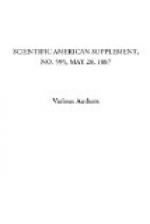A reference to the meteorological returns issued by the registrar-general shows that on the 12th of January, 1881, began a period of severe frost, characterized by still, sometimes foggy, weather, with occasional light airs from nearly all points of the compass. This state of affairs continued till January 18, when there was a notable snow storm, and a gale from the E.N.E. For four days, up to and inclusive of January 8, ozone was present in more than its usual amounts. During January 9-16, it was absent. On January 17 it reappeared, and on January 18 it was abundant. Similar meteorological conditions (calm and no ozone) were found to precede previous epidemics.
Mr. Power’s report, with regard to Fulham, seems conclusive, and there is a strong impression that hospitals, other than Fulham, have served as centers of dissemination.
In the last lecture I gave you the opinion of M. Bertillon, of Paris, and quoted figures in support of that opinion. It is a fact of some importance to remember that small-pox is one of those diseases which has a peculiar odor, recognizable by the expert. As to its conveyance for long distances through the air, there are some curious facts quoted by Professor Waterhouse, of Cambridge, Massachusetts, in a letter addressed to Dr. Haygarth at the close of the last century. Professor Waterhouse states that at Boston there was a small-pox hospital on one side of a river, and opposite it, 1,500 yards away, was a dockyard, where, on a certain misty, foggy day, with light airs just moving in a direction from the hospital to the dockyard, ten men were working. Twelve days later all but two of these men were down with small-pox, and the only possible source of infection was the hospital across the river. (To be continued.)
* * * * *
SUNLIGHT COLORS.
[Footnote: Lecture delivered by Capt. W. De W. Abney, R.E., P.B.S., at the Royal Institution, on February 25, 1887.—Nature.]
By Capt. W. DE W. ABNEY.
Sunlight is so intimately woven up with our physical enjoyment of life that it is perhaps not the most uninteresting subject that can be chosen for what is—perhaps somewhat pedantically—termed a Friday evening “discourse.” Now, no discourse ought to be be possible without a text on which to hang one’s words, and I think I found a suitable one when walking with an artist friend from South Kensington Museum the other day. The sun appeared like a red disk through one of those fogs which the east wind had brought, and I happened to point it out to him. He looked, and said, “Why is it that the sun appears so red?” Being near the railway station, whither he was bound, I had no time to enter into the subject, but said if he would come to the Royal Institution this evening I would endeavor to explain the matter. I am going to redeem that promise, and to devote at all events a




